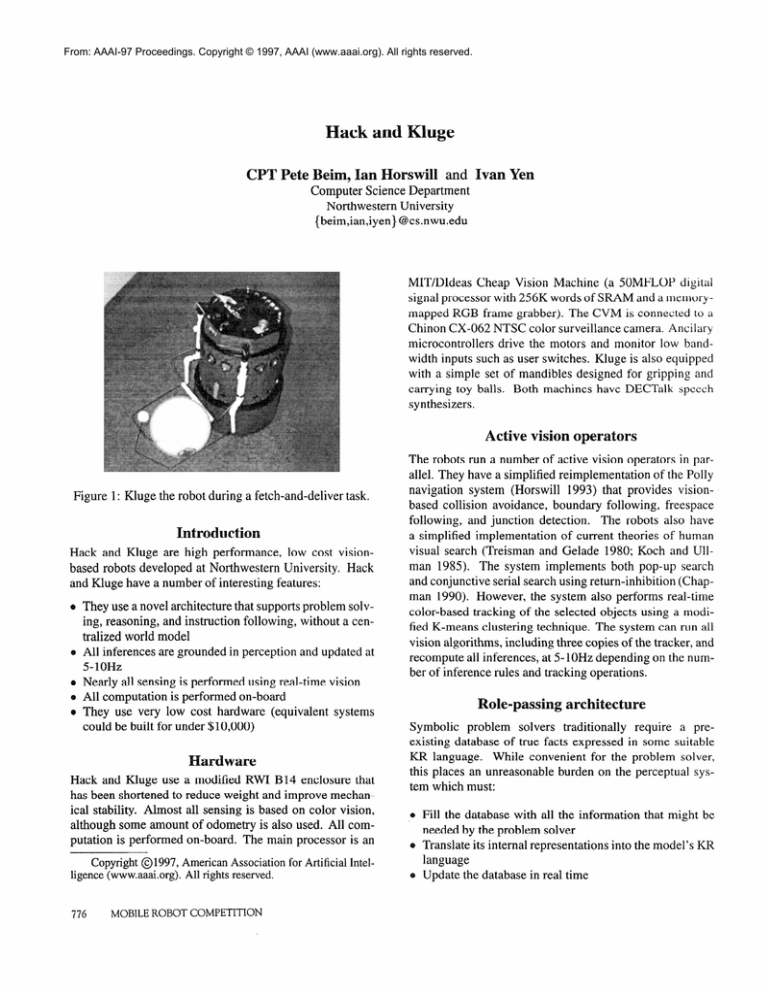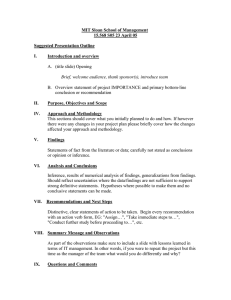
From: AAAI-97 Proceedings. Copyright © 1997, AAAI (www.aaai.org). All rights reserved.
GPT Pete Beim, Ian
Ivan Yen
Computer Science Department
Northwestern University
{beim,ian,iyen} @cs.nwu.edu
MIT/DIdeas Cheap Vision Machine (a SOMFLQP digital
signal processor with 256K words of SRAM and a rnemorymapped RGB frame grabber). The CVM is connected to a
Chinon CX-062 NTSC color surveillance camera. Ancilary
microcontrollers
drive the motors and monitor low bandwidth inputs such as user switches. Kluge is also equipped
with a simple set of mandibles designed for gripping and
carrying toy balls. Both machines have DECTalk speech
synthesizers.
Active vision operators
Figure 1: Kluge the robot during a fetch-and-deliver
task.
Introduction
Hack and Kluge are high performance, low cost visionbased robots developed at Northwestern University. Hack
and Kluge have a number of interesting features:
They use a novel architecture that supports problem solving, reasoning, and instruction following, without a centralized world model
All inferences are grounded in perception and updated at
5-10Hz
Nearly all sensing is performed using real-time vision
All computation is performed on-board
They use very low cost hardware (equivalent systems
could be built for under $10,000)
ardware
Hack and Kluge use a modified RWI B14 enclosure that
has been shortened to reduce weight and improve mechanical stability. Almost all sensing is based on color vision,
although some amount of odometry is also used. All computation is performed on-board. The main processor is an
Copyright 01997, American Association for Artificial Intelligence (www.aaai.org). All rights reserved.
776
MOBILE ROBOT COMPETITION
The robots run a number of active vision operators in parallel. They have a simplified reimplementation
of the Polly
navigation system (Horswill 1993) that provides visionbased collision avoidance, boundary following, freespace
following, and junction detection.
The robots also have
a simplified implementation
of current theories of human
visual search (Treisman and Gelade 1980; Koch and Ullman 1985). The system implements both pop-up search
and conjunctive serial search using return-inhibition
(Chapman 1990). However, the system also performs real-time
color-based tracking of the selected objects using a modified K-means clustering technique. The system can run all
vision algorithms, including three copies of the tracker, and
recompute all inferences, at 5- 1OHz depending on the number of inference rules and tracking operations.
Role-passing
architecture
Symbolic problem solvers traditionally
require a preexisting database of true facts expressed in some suitable
KR language.
While convenient for the problem solver,
this places an unreasonable burden on the perceptual system which must:
Fill the database with all the information that might be
needed by the problem solver
Translate its internal representations into the model’s KR
language
Update the database in real time
e Inform the problem solver when premises have changed
and inferences must be updated
These problems are severe enough that symbolic problem
solvers running on real robots do not update their databases
with perception, or only update carefully selected portions
of it. Often times, the bulk of the model is entered by hand.
While one can imagine many ways of modifying SMPE
architectures to make the database easier to generate, we
have taken the approach of directly interfacing the problem
solver to the perceptual system, eliminating the database
entirely. We have developed a technique called role-passing
that preserves the efficiency and parallelism of behaviorbased systems while supporting restricted forms of logical
reasoning. A role-passing system consists of:
o A set sensory pools
Q A set of parameterized behaviors
e A set of inference rules for triggering behaviors
A sensory pool is a collection of identical sensory processes
(e.g. visual trackers) that can represent a specific kind of
sensory information about an object. Each sensory process can be dynamically bound to one or more indexicalfunctional names, or roles. Behaviors communicate with
pools by specifying the role about which they need information. The sensory process bound to that role then answers
with the appropriate information.
In a sense, role-passing
provides a more programable version of deictic representation (Agre 1988). Using role-passing, we have developed
techniques for mapping a useful subset of modal logic with
equality into fast feed-forward networks grounded by sensory data (Horswill 1997). We have also shown how backtracking inference systems such as Prolog can be driven by
perceptual data using role-passing (Horswill 1995).
At present, Hack and Kluge implement a tracker pool
for tracking the visual positions of objects, an odometer
pool for dead reckoning the positions of objects out of view,
and a description pool for remembering visual descriptions
(color, size) of objects.
Example task
A typical task for Kluge would be to follow a natural language instruction such as “bring the blue ball here,” “follow
me,” or “bring Hack the green ball.” A simple finite-state
parser reads the instruction and binds the appropriate sensory processes to the roles OBJECT (the object to carry or
follow) and DESTINATION (the place or object to deliver
to), then sets the appropriate goal, usually either DELIVER
or FOLLOW.
Once the initial role bindings are established, the inference engine posts the goal of having the OBJECT in the
mandibles. This progates through the network to post the
subgoal of being near the OBJECT, which posts the subgoal
of binding the OBJECT in the tracker pool. The inference
network then triggers a visual search for OBJECT, causing
the tracker pool bind a tracker to OBJECT and set it looking for the color specified in the description pool. When the
tracker acquires its target, the inference network marks the
distance and orientation of OBJECT as known, allowing the
driving behaviors of the robot to activate. After driving to
and grabbing the object, the goal of the OBJECT being in
the hand becomes satisfied and the inference engine posts
the goal of being near the DESTINATION, repeating the
visual search and driving processes.
Since all inference is performed in a feed-forward network, inferences are updated every clock tick (lOO-200ms).
This allows the robot to respond to contingencies as soon
as they are sensed. For example, if someone steals the ball
while the robot is trying to deliver it, the inference network
immediately marks the ball as not being in the hand, retracts
the goal of being near the DESTINATION, and reposts the
goal of acquiring the OBJECT.
Support for this research was provided in part by the
National Science Foundation
under grant number IRI9407273. The Institute for the Learning Sciences was established in 1989 with the support of Anderson Consulting,
part of the Arthur Anderson Worldwide Organization.
eferences
Philip E. Agre. The dynamic structure of everyday life.
Technical Report 1085, Massachusetts Institute of Technology, Artificial Intelligence Lab, October 1988.
David Chapman. Vision, instruction, and action. Technical Report 1204, Massachusetts Institute of Technology,
Artificial Intelligence Lab, April 1990.
Ian Horswill. Polly: A vision-based artificial agent. In
Proceedings of the Eleventh National Conference on Artijicial Intelligence, pages 824-829, Cambridge, MA, 1993.
AAAI, MIT Press.
Ian Horswill. Visual routines and visual search. In Proceedings of the 14th InternationalJoint
Conference on Artificial Intelligence, Montreal, August 1995.
Ian Horswill. Real-time control of attention and behavior in a logical framework.
In W. Lewis Johnson, editor, Proceedings of the First International Conference on
Autonomous Agents, pages 130-137, Marina de1 Rey, CA
USA, February 1997. ACM SIGART, ACM Press.
C. Koch and S. Ullman. Shifts in selective visual attention:
Towards the underlying neural circuitry. Human Neurobiology, 21219-227,
1985.
Anne M. Treisman and Garry Gelade. A feature integration theory of attention.
Cognitive Psychology, 12:97136, 1980.
MOBILE ROBOT COMPETITION
777





